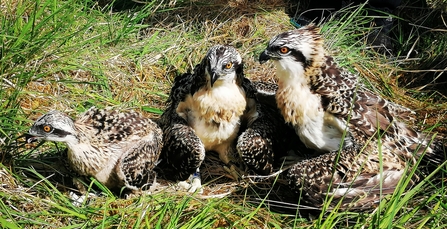
Three osprey chicks were ringed at Foulshaw Moss Nature Reserve recently © Danni Chalmers
Gifting membership? Order by Wednesday 17 December in time for Christmas.

Three osprey chicks were ringed at Foulshaw Moss Nature Reserve recently © Danni Chalmers
Three six-week-old osprey chicks were tagged with ID rings at Foulshaw Moss Nature Reserve recently, one of Cumbria’s key breeding sites for these spectacular birds of prey. It was a key moment in osprey conservation, as 100 osprey chicks have now been ringed in Cumbria since 2001.
Paul Waterhouse, Reserves Officer for Cumbria Wildlife Trust, visited the nest site, to accompany a licenced and experienced bird ringer, brought in to tag the chicks with ID rings. As the osprey is a Schedule 1 protected species, only those with a licence from the British Trust for Ornithology (BTO) are permitted to approach and handle the birds. The parent birds kept a watch on the wing as the three chicks were carefully lowered from their tree-top nest. The process took no longer than 30 minutes and neither parent birds nor chicks seemed unduly alarmed by the activity. As well as being ringed with blue ID bands, they were weighed, measured and checked over.
Paul Waterhouse said: “I’m incredibly pleased that we have ringed another three osprey chicks at Foulshaw Moss Nature Reserve this year. For a time we we’re unsure if the smallest chick was going to make it. It was rapidly being outgrown by its bigger siblings but it carried on fighting for its share of the food from mum and dad. Now there’s not much difference in weight – and it was the smallest one that was the 100th osprey chick to be ringed in Cumbria since 2001! Osprey chicks are weighed by the licenced bird ringer and each chick is given a coloured leg ring. This year we have Blue 462, a female weighing 1.6kg, Blue 463 weighing 1.5kg – gender unknown, and Blue 464, a male weighing 1.6kg”.
“These tags are invaluable as they enable us to identify the birds individually, keep tracks of their movements and understand their life history. They have been fitted with metal BTO rings, as part of the national bird ringing scheme and also a plastic colour ring, which allows individual birds to be identified in the field using a telescope or telephoto camera.”
All three chicks are doing very well. As fully-grown adults their wingspan will be around 152cm–167cm (about 5 feet), making them one of the largest birds of prey in the UK.
The osprey chicks are expected to fledge in the next couple of weeks and will fly the nest at the end of summer, before they start their hazardous first migration to southern Spain or West Africa. Until then, you can continue to watch their progress on our osprey webcam.
Foulshaw Moss Nature Reserve is open daily to visitors but you are asked to follow social distancing guidelines and respect the one-way routes round the nature reserve. If it is busy when you arrive at the car park, please come back at another time.
This year, telescopes aren’t available for viewing the osprey nest, to comply with health and safety requirements for Coronavirus, but our volunteers will be nearby to talk to you about the ospreys.
Follow the Foulshaw Moss ospreys on social media #FoulshawOspreys